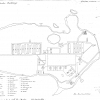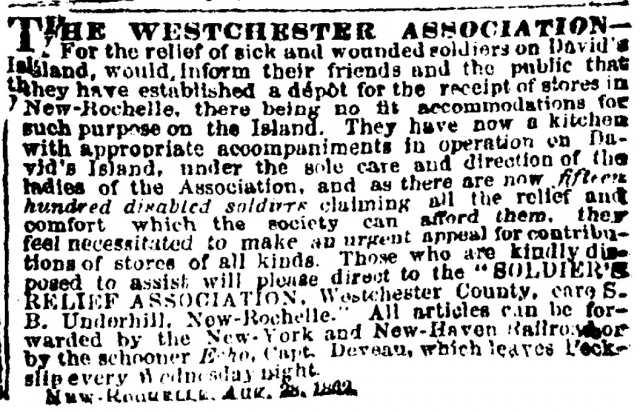|
The Army arrived on Davids Island during the crisis of the Civil War. Its military career began as a mustering ground for volunteers, but the federal government soon leased the island and built a general hospital.
Civil War
In the fall of 1861, the 3rd Regiment of the Irish Brigade (63rd Regiment New York Volunteers) camped on the island for several weeks. According to an 1861 article in The New York Times, the regiment’s 900 men acquired “great proficiency in drill,” before departing for Washington, D.C., at the end of November 1861.
The following spring, the U.S. Army established a general hospital for troops wounded in battle. The early months of the Civil War had severely strained the Army Medical Department, nearly overwhelmed by the Army’s vast new size and the war’s enormous casualties. In response, the Army established 150 general hospitals throughout the North in late 1861 and early 1862, including one on Davids Island. In April 1862, the War Department subleased the island from Simeon Leland, an hotelier, who had recently leased it from Thaddeus Davids, the island’s owner at the time.
The government immediately began constructing De Camp General Hospital, which opened in May 1862. It was a hastily-built facility consisting of over 50 frame buildings of the simplest possible construction—“mere barrack sheds” in the words of an 1862 War Department telegram.
The installation included a main hospital; quarters and barracks; storehouses, stables, and shops; bakeries, cookhouses, and messes, and some 20 long, barracks-like pavilion buildings for convalescing patients. Neat ranks of canvas tents with wood floors provided space for additional patients. By late 1862, De Camp was the Army’s largest general hospital, housing more than 2,100 patients.
Army personnel ran and staffed the hospital, and the Quartermaster and Medical corps supplied it. However, the needs of the wounded and sick soldiers were great, and soldiers’ aid societies from Westchester County and the surrounding region supplemented the Army’s efforts. These societies, civilian groups typically organized by patriotic women, began to form in communities throughout the country almost as soon as the war’s hostilities commenced. At De Camp General Hospital, the societies operated three kitchens that provided food not available in Army rations; they collected books, extra clothing, and other supplies; and they offered general comfort care for the convalescents.
Originally, De Camp General Hospital treated only Union soldiers, but following the Battle of Gettysburg in July 1863, the War Department opened it to care for hundreds of wounded Confederate soldiers. Davids Island soon held more than 2,500 Confederate prisoners. Most had recovered by October, and they were moved to prisoner-of-war camps elsewhere. For the balance of the war, De Camp occasionally treated groups of Confederate prisoners, who stayed at the hospital along with sick and wounded Union soldiers.
Blue and Gray (1861 - 1878)
Post-War Use
In late 1866, with the Civil War ended and wounded soldiers transferred home, De Camp General Hospital closed. As the Army closed its general hospitals after the Civil War, it typically returned leased property to the control of landowners. This was not the case with Davids Island. Instead, the War Department purchased the island from Simeon Leland for $38,500 on May 11, 1867. Just before the sale, Leland, formerly the leaseholder, acquired the island from Thaddeus Davids.
During the late 1860s and early 1870s, the Army used the island periodically as a camp for unit reorganization and a subdepot for recruits in conjunction with the Army’s main depot on Governors Island. By the early 1870s, the hastily-built wood frame buildings of the Civil War had deteriorated badly, and in October 1874 the Army withdrew from the island for nearly four years.
|
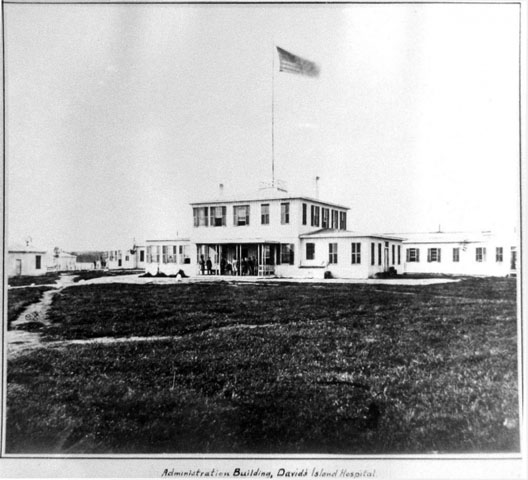

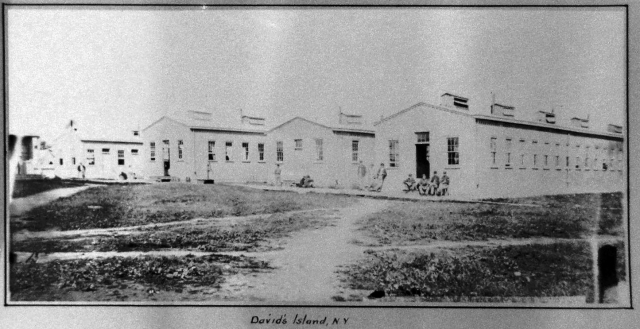

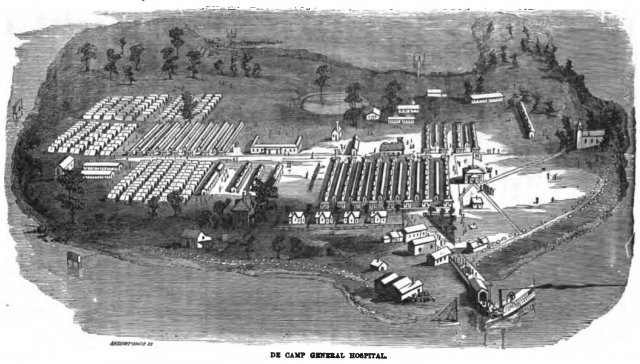





 Blue and Gray (1861 - 1878)
Blue and Gray (1861 - 1878)
